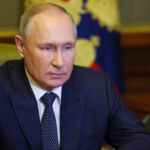
(Bloomberg) — North Korea fired at least three ballistic missiles Thursday, including one long-range rocket that Japan said may have been an intercontinental ballistic missile that came close enough to the country to trigger an alert.
Most Read from Bloomberg
Japan said the missile fell into the waters off its western coast, after initially saying that it had flown over the country’s territory and alerting residents to take cover. The launches follow a record single-day barrage from Kim Jong Un’s regime, that included the first ballistic missile it has shot across a nautical border with South Korea.
Japanese Prime Minister Fumio Kishida told reporters that one of the North Korean rockets fired off Thursday might have been an ICBM. Pyongyang’s last test of a ICBM was in May this year, and the weapon is intended to carry a nuclear warhead to the US mainland.
North Korea started this week by threatening to take “powerful measures” if the US doesn’t halt military drills with partners including South Korea, in what might be an effort by Kim to lay the groundwork for his first nuclear test in five years. It then fired off at least 23 missiles on Wednesday a little more than a day after its warning.
Japan issued an alert that urged its residents in northeastern regions to take cover Thursday morning, after Tokyo said a missile flew over the country’s territory into the Pacific Ocean. Defense Minister Yasukazu Hamada later said the missile didn’t fly over and instead apparently splashed down in the sea to the west of Japan.
South Korea’s Joint Chiefs of Staff said the first missile launch took place at 7:44 a.m. local time from an area near Pyongyang’s main international airport. That missile reached an altitude of about 2,000 kilometers (1,240 miles) and traveled a distance of 750 kms, Japan said. This would be consistent with a lofted trajectory for a longer-range rocket that is shot high into the sky, something that North Korea has done before.
North Korea followed by launching a short-range ballistic missile at 8:42 a.m. toward waters off its east coast and another short-range ballistic missile at 9:12 a.m., South Korea’s JCS said.
“We are concerned about the potential for further provocations, including and up to a seventh nuclear test,” US State Department spokesperson Ned Price said Wednesday. “We’ll continue to place an emphasis on trilateral cooperation with our South Korean and Japanese allies together.”
Secretary of State Antony Blinken spoke to his South Korean counterpart and the two minister condemned the escalatory launches including one that “recklessly and dangerously” landed near the coastline, Price said.
Read more: North Korea Fires Off Biggest-Ever Daily Missile Barrage
Washington, Tokyo and Seoul have promised a coordinated response if Pyongyang sets off an atomic device, which — like ballistic missile launches — would be a violation of United Nations Security Council resolutions.
The nuclear test might be used to advance Kim’s pursuit of miniaturized nuclear warheads to mount on missiles to strike South Korea and Japan, which host the bulk of America’s troops in Asia.
The North Korean leader is finding space to ramp up provocations as the Biden administration focuses on Russia’s war in Ukraine. Russia and China, two long-time partners of North Korea, have veto power at the UN Security Council and have shown no intent to punish Kim with extra sanctions.
North Korea had previously fired a ballistic missile over Japan last month, the first such test since 2017.
The US and South Korea this week started air drills known as Vigilant Storm that will run through Friday and involve about 240 aircraft in about 1,600 sorties to “hone their wartime capabilities,” the US 7th Air Force said in a statement. The drills have added to a series of joint exercises on land, sea and air in recent weeks, some of which have also included Japan, that have led to complaints and provocations from Pyongyang.
Since the end of September, when the USS Ronald Reagan aircraft carrier group was in the region for exercises, North Korea has fired one of its biggest barrages of missiles under Kim.
–With assistance from Min Jeong Lee and Aaron Clark.
(Updates with details on launches.)
Most Read from Bloomberg Businessweek
©2022 Bloomberg L.P.




